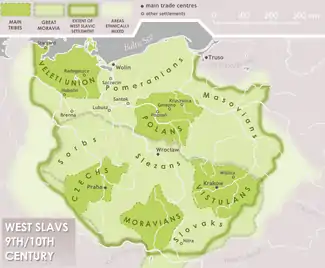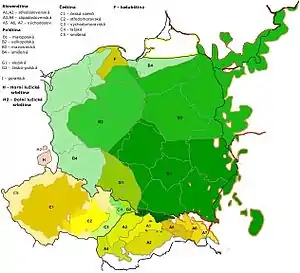West Slavs
The West Slavs are a subgroup of Slavic peoples who speak the West Slavic languages. They separated from the common Slavic group around the 7th century, and established independent polities in Central Europe by the 8th to 9th centuries. The West Slavic languages diversified into their historically attested forms over the 10th to 14th centuries.
 West Slavic countries | |
| Total population | |
|---|---|
| c. 80 million | |
| Regions with significant populations | |
| Central Europe, historically Western Europe (modern-day Eastern Germany) | |
| Poles | c. 60 million |
| Czechs | c. 10–12 million |
| Slovaks | c. 6–7 million |
| Silesians | c. 2–5 million[1](847,000 as nationality)[2] (included in Poles) |
| Kashubians | c. 500,000[3] (228,000 as nationality)[2] (included in Poles) |
| Moravians | c. 500,000 (included in Czechs) (630 899 as nationality[4]) |
| Sorbs | c. 60,000[5]–80,000[6] |
| Religion | |
| Catholicism (Poles, Slovaks, Silesians, Kashubians, Moravians and minority among Sorbs and Czechs) Protestantism (majority among Sorbs) irreligious (majority among Czechs) | |
| Related ethnic groups | |
| Other Slavs (especially Catholic Slavs, i.e. Slovenes and Croats) | |


West Slavic speaking nations today include the Poles, Czechs, Slovaks, Sorbs and ethnic groups Kashubians, Moravians and Silesians. They inhabit a contiguous area in Central Europe stretching from the north of the Baltic Sea to the Sudetes and the Carpathian Mountains in the south, historically also across the Eastern Alps into the Apennine peninsula and the Balkan peninsula.
The West Slavic group can be divided into three subgroups: Lechitic, including Polish, Kashubian and the extinct Polabian and Pomeranian languages as well as Lusatian (Sorbian) and Czecho-Slovak.[7] Culturally, West Slavs developed along the lines of other Western European nations due to affiliation with the Roman Empire and Western Christianity. Thus, they experienced a cultural split with the other Slavic groups: while the East Slavs and part of South Slavs converted to Orthodox Christianity, thus being culturally influenced by the Byzantine Empire, all the West Slavs converted to Roman Catholicism, thus coming under the cultural influence of the Latin Church.
History
In the Middle Ages, the name "Wends" (derived from Roman-era Veneti) was applied to Western Slavic peoples. Mieszko I, the first historical ruler of Poland, also appeared as "Dagome, King of the Wends".(need to be confirmed by sources)
The early Slavic expansion began in the 5th century, and by the 6th century, the groups that would become the West, East and South Slavic groups had probably become geographically separated. The first independent West Slavic states originate beginning in the 7th century, with the Empire of Samo (623–658), the Principality of Moravia (8th century–833), the Principality of Nitra (8th century–833) and Great Moravia (833–c. 907). The Sorbs and other Polabian Slavs like Obodrites and Veleti came under the domination of the Holy Roman Empire after the Wendish Crusade[8] in the Middle Ages and had been strongly Germanized by Germans at the end of the 19th century. The Polabian language survived until the beginning of the 19th century in what is now the German state of Lower Saxony.[9]
At this time only 60,000-80,000 Sorbs have survived as a group which kept its language and traditions, living predominantly in Lusatia, a region in modern Germany in the states of Brandenburg and Saxony.[10] However, the process of Germanization should not be understood as an expulsion by German settlers. The relationship between Slavs and Germans varied, depending on time and region. Often, German and Slavic villages co-existed as neighbours for centuries. In today's Saxony, many geographic names, even these of major cities such as Dresden, Leipzig or Zwickau are of Slavic origin. The Wendish Crusade did not involve these areas and the development of Slavic and German interaction remained largely peaceful.
The central Polish tribe of Western Polans created their own state in the 10th century under the Polish duke Mieszko I. For many centuries Poland has had close ties with its western neighbors, with the Polish ruler Bolesław I the Brave declared by Holy Roman Emperor Otto III as Frater et Cooperator Imperii ("Brother and Partner in the Empire").[11]
The precursors of the Czechs (i.e. Bohemians) migrated into Bohemia in the late 6th century and had established various fiefdoms by the 10th century when their rulers eventually became vassals (1002) of the Holy Roman Emperors. Kingdom of Bohemia stayed part of that Empire between 1002–1419 and 1526–1918. Predecessors of Slovaks came under Hungarian domination after 907 (doom of the Great Moravia) – together with other Slavic groups as Croats, Slovenians, Serbs and Rusyns. Both the Czechs and the Slovaks were under the rule of the Habsburg monarchy from 1526 to 1804; then in the Austrian Empire and between 1867–1918 part of Austria-Hungary.
Tribal groups
- Lechitic group[12]
- Poles
- Masovians
- Polans
- Lendians
- Vistulans
- Silesians
- Pomeranians[12]
- Polabians[12]
- Obodrites/Abodrites
- Obotrites proper
- Wagrians
- Warnower
- Polabians proper
- Linonen
- Travnjane
- Drevani
- Veleti (Wilzi), succeeded by Lutici (Liutici)
- Kissini (Kessiner, Chizzinen, Kyzziner)
- Circipani (Zirzipanen)
- Tollensians
- Redarier
- Ucri (Ukr(an)i, Ukranen)
- Rani (Rujani)
- Hevelli (Stodorani)
- Volinians (Velunzani)
- Pyritzans (Prissani)
- Obodrites/Abodrites
- Czech–Slovak group
- Sorbian group[12]
- Milceni (Upper Sorbs)
- Lusatian Sorbs (Lower Sorbs)
Bavarian Geographer
In 845 the Bavarian Geographer made a list of West Slavic tribes who lived in the areas of modern-day Poland, Czech Republic, Germany and Denmark:[13]
| Pos. | Latin name in 845 | English name | no. of gords |
|---|---|---|---|
| 1 | Nortabtrezi | North Obotrites | 53 |
| 2 | Uuilci | Veleti | 95 |
| 7 | Hehfeldi | Hevellians | 8 |
| 14 | Osterabtrezi | East Obotrites | 100 |
| 15 | Miloxi | Milceni[13] | 67 |
| 16 | Phesnuzi | Besunzane[13] | 70 |
| 17 | Thadesi | Dadosesani[13] | 200 |
| 18 | Glopeani | Goplans | 400 |
| 33 | Lendizi | Lendians | 98 |
| 34 | Thafnezi | / | 257 |
| 36 | Prissani | Prissani | 70 |
| 37 | Uelunzani | Wolinians | 70 |
| 38 | Bruzi | / | |
| 48 | Uuislane | Vistulans | / |
| 49 | Sleenzane | Silesians | 15 |
| 50 | Lunsizi | Sorbs | 30 |
| 51 | Dadosesani | Thadesi[13] | 20 |
| 52 | Milzane | Milceni | 30 |
| 53 | Besunzane | Phesnuzi[13] | 2 |
| 56 | Lupiglaa | Łupigoła[13] | 30 |
| 57 | Opolini | Opolans | 20 |
| 58 | Golensizi | Golensizi | 5 |
| Latin Wikisource has original text related to this article: |
Linguistic grouping

See also
References
- "The Institute for European Studies, Ethnological institute of UW" (PDF). Retrieved 2012-08-16.
- "Wyniki Narodowego Spisu Powszechnego 2011, GUS" (PDF). Retrieved 2011. Check date values in:
|access-date=(help) - "The Institute for European Studies, Ethnological institute of UW" (PDF). Retrieved 2012-08-16.
- 2011 in Czech Republic and Census 2011 in Slovak Republic
- Catherine Hickley. Germany's Sorb Minority Fights to Save Villages From Vattenfall. Bloomberg. December 18, 2007.
- "Sorbs of East Germany". faqs.org. Retrieved 18 March 2015.
- Bohemia and Poland. Chapter 20.pp 512-513. [in:] Timothy Reuter. The New Cambridge Medieval History: c. 900-c.1024. 2000
- Christiansen, Erik (1997). The Northern Crusades. London: Penguin Books. p. 287. ISBN 0-14-026653-4.
- Polabian language
- Die Sorben in Deutschland, M.Schiemann, Stiftung für das sorbische Volk, Görlitz 1997
- Rez. MA: M. Borgolte (Hg.): Polen und Deutschland vor 1000 Jahren - H-Soz-u-Kult / Rezensionen / Bücher
- Jerzy Strzelczyk. Bohemia and Poland: two examples of successful western Slavonic state-formation. In: Timothy Reuter ed. The New Cambridge Medieval History: c. 900-c. 1024. Cambridge University Press. 1995. p. 514.
- Krzysztof Tomasz Witczak (2013). "Poselstwo ruskie w państwie niemieckim w roku 839: Kulisy śledztwa w świetle danych Geografa Bawarskiego". Slavia Orientalis (in Polish and English). 62 (1): 25–43.
